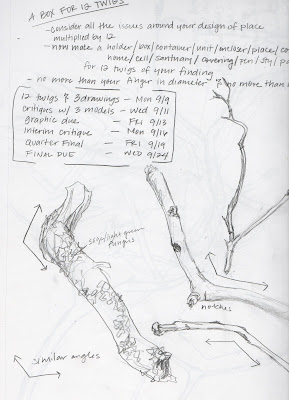



Like my Place for a Leaf, I wanted to pull characteristics from the twigs I found and work them into a main idea. Also, after defining each 'box' term, I decided to create a system where the objects inside work with the exterior to support each other. At first I drew out six squares with random twig-like patterns in each, cut them out and tied the corners together to form a cube. But this binding was weak, the paper was flimsy, and the cut-out patterns had no order to them to create 'spots' for each twig to lay. I then came up with a pattern that worked in a similar way to the Leaf project. I drew the six squares connected into a cross, used the same branch pattern in each (only I rotated the pattern throughout each square), cut the whole pattern out of gray poster board and folded it up into a cube. This time I also included little tabs around the outside of the pattern to fold around the neighboring walls to keep a cube form. This iteration worked a lot better - the tabs were stronger and made more sense than the twine and the poster was much sturdier for holding the twelve twigs.
I tried working with a few other materials. For example, I attempted to cut out the walls from foam core in hopes to utilize the foam's layers to get different textures in the walls. But making that many clean cuts on such an intricate design was too challenging. But while working with the foam core, I did succeed in finding a good way to bind my walls.












